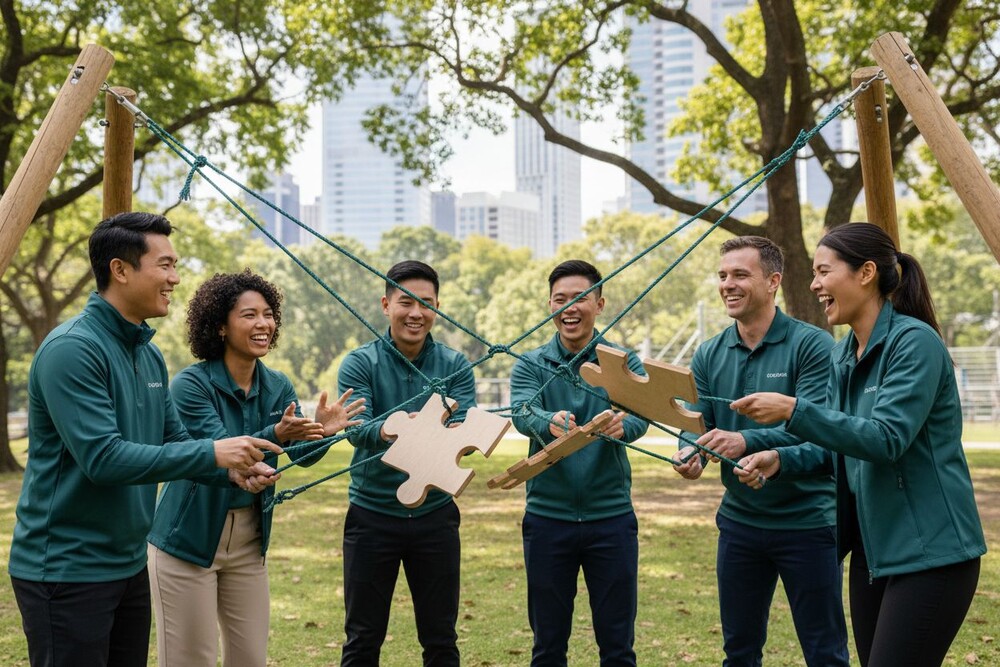When individuals step outside their comfort zones and typical workplace hierarchies, they discover new strengths, develop deeper mutual understanding, and learn to leverage each other’s unique capabilities more effectively.
Popular Types of Outdoor Team Activities
Outdoor team activities span a diverse range of experiences designed to challenge, engage, and unite teams in unique environments. Explore our comprehensive guide to team building activities to discover the full spectrum of transformative group experiences available.
According to research from industry experts, adventure-based challenges form a significant category of outdoor team activities. These include dynamic experiences like obstacle courses, zip-lining, and rock climbing that push participants beyond their comfort zones. Each activity strategically tests physical limits while simultaneously developing communication, trust, and collaborative problem-solving skills.
Typical outdoor team activities can be categorized into several engaging formats:
- Adventure Challenges: Physical obstacle courses and high-intensity activities
- Problem-Solving Games: Treasure hunts, survival scenarios, strategic navigation missions
- Sports-Based Tournaments: Competitive team sports that require coordination and strategy
- Nature-Based Retreats: Camping experiences focused on collective survival and teamwork
- Trust-Building Exercises: Blindfolded challenges, trust falls, and collaborative rescue scenarios
- Corporate Social Responsibility (CSR) Activities: Environmental clean-ups, community service projects
These diverse activities share a common goal: transforming individual team members into cohesive, high-performing units.
By removing traditional workplace constraints and placing participants in dynamic, unpredictable environments, organizations can unlock new dimensions of team potential, fostering deeper connections and more effective collaborative strategies.
Here’s a summary of common outdoor team activity types and their primary benefits:
| Activity Type |
Example Activities |
Key Benefits |
| Adventure Challenges |
Obstacle courses
Rock climbing |
Trust-building
Physical engagement |
| Problem-Solving Games |
Treasure hunts
Survival scenarios |
Collaboration
Creative thinking |
| Sports-Based Tournaments |
Team sports
Relay races |
Coordination
Healthy competition |
| Nature-Based Retreats |
Camping
Group hiking |
Wellness
Cohesion |
| Trust-Building Exercises |
Trust falls
Blindfolded walks |
Mutual support
Communication |
| CSR Activities |
Environmental clean-up
Community service |
Social impact
Employee engagement |
Core Benefits for Corporate Teams and Businesses
Outdoor team activities deliver substantial organizational advantages that extend far beyond simple entertainment. Learn more about corporate team games and their strategic impact to understand the nuanced benefits these experiences provide.
According to research from McKinsey, spending time in nature dramatically improves cognitive functioning and team performance. These wilderness-based experiences enhance participants’ attention spans, creativity, and overall well-being, resulting in sustained organizational productivity. Mental clarity and team cohesion emerge as direct outcomes of strategically designed outdoor activities.
Key benefits for corporate teams include:
- Enhanced communication skills
- Improved problem-solving capabilities
- Accelerated trust-building among team members
- Significant stress reduction
- Promotion of physical and mental wellness
- Natural leadership skill development
- Increased team adaptability and resilience
Corporate Wellness Magazine highlights that outdoor adventure activities fundamentally transform team dynamics. By removing traditional workplace constraints, organizations create environments where employees can genuinely connect, challenge themselves, and develop deeper professional relationships. These experiences aren’t just team-building exercises—they’re strategic investments in human capital that yield measurable improvements in organizational performance and employee engagement.
Practical Considerations for Implementation
Successful outdoor team activities require strategic planning and thoughtful design. Discover expert tips for planning effective team building events to ensure your organization creates meaningful experiences.
According to McKinsey research, implementing outdoor activities demands careful consideration of participant diversity and engagement strategies. Organizations must design inclusive options that accommodate varying physical abilities, ensuring every team member can participate and benefit from the experience. This approach prevents marginalization and promotes genuine team connection.
Key practical implementation considerations include:
- Participant Assessment: Evaluate team members’ physical capabilities and comfort levels
- Activity Selection: Choose scalable challenges with multiple participation modes
- Technology Management: Plan deliberate technology disconnection periods
- Safety Protocols: Develop comprehensive risk management and emergency response plans
- Logistical Planning: Consider transportation, equipment, and environmental conditions
- Inclusive Design: Create alternative participation paths for different physical abilities
- Post-Activity Reflection: Schedule structured debriefing and learning sessions
Successful implementation transforms outdoor team activities from simple events into strategic organizational development opportunities. By prioritizing inclusive design, safety, and meaningful engagement, businesses can create powerful experiences that genuinely enhance team dynamics, individual growth, and collective performance.
Comparing Outdoor, Virtual, and Hybrid Activities
Learn more about the nuances of team building approaches to understand the strategic advantages of different engagement models. Modern organizations now have unprecedented flexibility in designing team experiences that transcend traditional workplace boundaries.
According to recent research on virtual team dynamics, hybrid engagement models offer unique opportunities for team development. Virtual reality environments can surprisingly enhance newcomers’ inclusion and perceived closeness, challenging traditional assumptions about remote interaction effectiveness. However, these models require intentional design to prevent potential communication breakdowns and maintain team cohesion.
Comparative characteristics of team building approaches:

